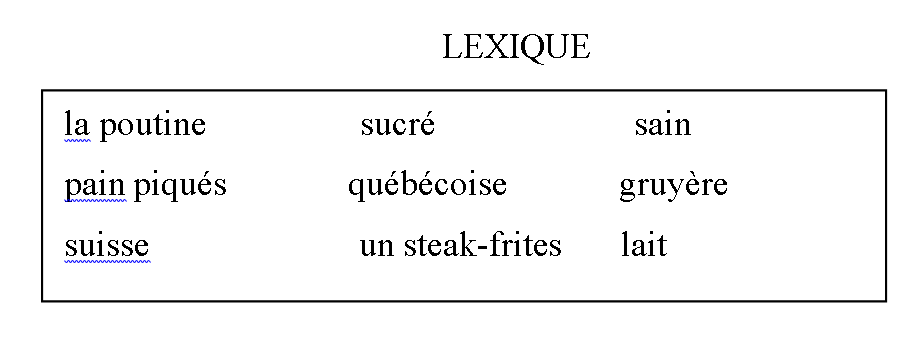Introductory words, also called one-word modifiers, are the same as dependent words
a. True
b. False
b
You might also like to view...
Use a word from the lexique to complete each sentence. You will not use all of the words

1. Le mélange de frites, de fromage en grains et de sauce brune s’appelle ____________________. C’est d’origine ____________________.
2. Récemment, le fast-food en France a évolué avec un menu qui est plus ____________________ que dans le passé.
3. Dans la recette pour la fondue suisse, il y a du ___________________, de l’emmental, du vin blanc, de l’ail, du Kirsch, du sel et du poivre.
4. Typiquement, on sert la fondue suisse avec des petits morceaux de _________________ piqués sur une fourchette.
Les préférences. While at the café, the four friends chat about their and other people's preferences for food and drink. Fill in the blanks with the correct stress pronouns to complete the conversation.
Fatma:Mon ami Alain adore la bière, (1) __________. Mais (2) __________, je ne bois pas de boissons alcoolisées. Et (3) ___________? Qu'est-ce que vous préfèrez? Jamal:J'aime le jus de fruits, alors, (4) ___________, je bois souvent du jus d'abricot. Mais Luna, (5) ___________, elle n'aime pas le jus d'abricot, n'est-ce pas, Luna? Luna:(6) ___________, j'adore, mais, Fatma, (7) ___________, elle n'aime pas. Mais (8) ___________, nous adorons l'eau minérale toutes les deux? Fatma:Oui, c'est vrai. Et (9) ___________, Messod, tu préfères le thé ou le café? Messod:Je préfère le thé. (10) ___________ aussi Jamal, non? Jamal:Oui. C'est bizarre, les gens ici, (11) ___________, ils ne boivent pas de thé comme nous au Maroc. (4) Fill in the blank(s) with the appropriate word(s).
Circle the word or phrase that best complete the sentence.
Tuvo que declararse en (promedio, efectivo, quiebra).
Read the following selection, then answer the multiple-choice questions based on the content of the passage. Use the concepts and skills you have learned from your textbook in any way that you feel will aid in your comprehension of the material.
The Persian Gulf War In August 1990, with Iraqi forces poised near the Saudi Arabian border (please refer to Map 1), the Bush administration dispatched 180,000 troops to protect the Saudi kingdom. The crisis took a dramatic turn in November 1990 when Bush doubled the number of American troops deployed in the Persian Gulf. Iraqi forces in Kuwait had climbed to 430,000 and coalition forces had to increase if Iraq was to be ejected from Kuwait by force. The president went to the United Nations for a resolution permitting the use of force against Iraq if it did not with- draw by January 15, 1991. After a heated debate, Congress also gave the president authority to wage war. The 545,000-strong Iraqi army, the world’s fourth largest, was equipped with antiship Exocet missiles, top-of-the-line Soviet T-72 tanks, and long-range artillery capable of firing nerve gas. Hussein tried to bring Israel into the war by launching Scud missiles at Israeli cities, a strategy thwarted when the United States sent Patriot antimissile missiles to Israel. A month of bombing gave the coalition forces air supremacy and destroyed thousands of Iraqi tanks and artillery pieces, supply routes and communications lines, and command-and-control bunkers, and limited Iraq’s ability to produce nuclear, chemical, and biological weapons. Iraqi troop morale suffered so badly during the bombing that an estimated 30 percent of Baghdad’s forces deserted before the ground campaign even started. The allied ground campaign relied on deception, mobility, and overwhelming air superiority to defeat a larger Iraqi army. The allied strategy was to mislead the Iraqis into believing that the allied attack would occur along the Kuwaiti coastline and Kuwait’s border with Saudi Arabia. Meanwhile, General H. Norman Schwarzkopf, U. S. commander of the coalition forces, shifted more than 300,000 U.S., British, and French troops into western Saudi Arabia, allowing them to strike deeply in Iraq and trap Iraqi forces deep in southern Iraq and Kuwait. Only 100 hours after the ground war started, the war ended. 1. It can be inferred from the passage that the Saudi Arabian government a. tried to keep the United States from entering the war. b. asked for assistance from the United States government. c. remained neutral throughout the war. 2. During the Persian Gulf War, the leader of the Iraqi forces was a. Schwarzkopf. b. Bush. c. Hussein. 3. It is implied in the selection that the United States Congress a. was eager to go to war. b. was reluctant to go to war. c. remained neutral in regard to war. 4. As used in the passage, thwarted most nearly means a. defeated. b. victorious. c. encouraged. 5. By reading Map 1, one can see that Iraq a. is south of Saudi Arabia. b. west of Syria. c. north of Saudi Arabia.